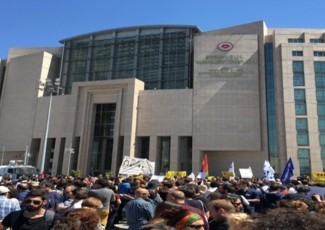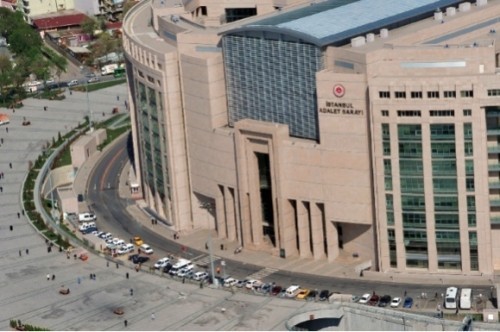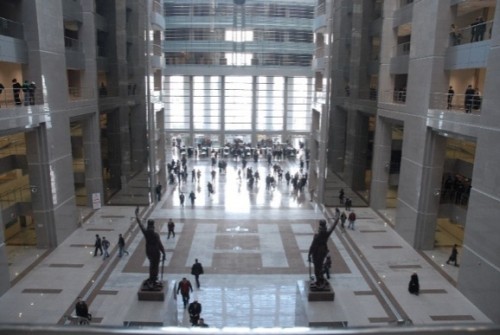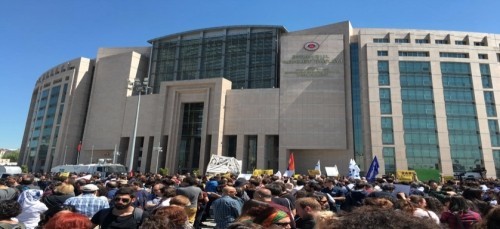All the anomalies of authoritarianism in contemporary Turkey seem telescoped, or short circuited in Istanbul’s “Palaces of Justice” (Adalet Sarayı). One of these “palaces” is on the Anatolian side in Kartal, and two in Europe, in Çağlayan and Bakırköy. These are all brand new buildings, inaugurated one after another by the incumbent AKP (Justice and Development Party) during its ten-year tenure in office.

Monumental in scale, they have been designed to centralize all thirty-five district courts dispersed in different parts of the city under one roof. And, akin to many attention-grabbing construction projects of the Erdoğan government, they have been described in superlatives. Thus, for instance, the Anatolian Palace of Justice (in Kartal) was publicized in the local media as “the largest public building ever built in Turkey,” as well as “the biggest court house in the world,” during the inauguration ceremonies in 2016.
Designed for the circulation of more than forty-five thousand citizens on a daily basis, with an estimated five thousand government personnel working on the premises, it has close to three hundred courtrooms, numerous conference halls, not to mention a huge parking lot for more than two thousand five hundred cars. In terms of architectural aesthetic however, it resembles a gigantic shopping mall, more than a building we would commonly think of as “palace” quality.
In many European languages, the phrase “palace of justice” denotes the grandiose state projects of the nineteenth century in European capitals, when imperial powers were competing with one another for hegemony (German: Justizpalast, Spanish: Palazzo di Justicia, Italian: Palazzo di Giustizia, French: Palais de Justice). The Palatzio di Guistizia in Rome for instance, considered one of the grandest buildings of the capital, took nearly twenty years to be built (1888-1910). Similarly, the Justizpalast of Vienna is a neo-Renaissance building erected from 1875 to 1881, designed by one of the most notable architects of the period, as the new residence of the Supreme Court and the Supreme Public Prosecutor. The majesty of such buildings, the sheer opulence of their ornamentation if you will, is of the kind we would associate with imperial power.

[Istanbul Palace of Justice (in Çağlayan). Image taken from the official website of the Ministry of Justice]
The architectural aesthetic of Istanbul’s Adalet Sarayı is more in tune with what many commentators have described as the “Dubaification of Istanbul.” The speculative building boom of the past two decades has led to a dizzying proliferation of shopping malls, high-rise offices and residential towers, convention halls, waterfront developments, and transportation facilities across the landscape of the city. The globally branded architecture of such spaces, each promoted as special and unique, could literally be found anywhere in the world. Since the mid-1990s, with the intervention of new technologies such as architectural glass, and computer aided design (CAD), the skyline of major metropolises in many parts of the world has been transformed by grand projects described as “daring” and “bold initiatives.” What marks these mega-projects is their explicitly profit-oriented and commodified nature. The corporate sector assumes a powerful role in their conceptualization, planning and execution. In the context of İstanbul, the dominant language of “entrepreneurial governance through public-private partnerships” has meant extensive privatization of state-owned urban land and property in Istanbul, as well as a growing role for real-estate developers in city planning and building. It has also enabled the incumbent AKP to promote itself as a party of grand vision and developmental prowess, by undertaking major investments which include a third airport and a third bridge in the forested areas towards the Black Sea coast. The ability of Erdoğan to project himself as a leader of determination and vision to face the future cannot be divorced from his heavily advertised public image as the author of such mega-construction projects.
No doubt, it is also possible to think of initiatives such as Istanbul’s Palaces of Justice as ritualistic reverence to majesty of justice, and by extension to the founding father of Justice and Development Party. As such, they are reminiscent of interwar decades in Europe, and the gigantism of modernist architecture associated with fascist regimes. Authoritarian regimes are rarely held accountable for investing massive amounts of resources for projects that do not always have popular support or functional outcomes. In the realization of such ambitious projects, intermittent financing is often a major problem. The steady flow of financing, which frequently works hand in hand with the ambitions of authoritarian leaders, means that major projects are realized in record time. This is why even opponents of the AKP government seem to somehow end up endorsing authoritarianism: “They get things done.”
The cultural/ideological aesthetic of Istanbul’s Palaces of Justice then, is an amalgam of grandiose, pseudo-imperialistic styles, overlaid by global symbols of corporate power. The vast parking lots, the security checks, the latest technologies of camera surveillance, the uniformed guards… all add up to the feeling of entering an airport, a transnational hotel, or a shopping mall in contemporary Istanbul. This feeling is amplified by the huge atriums, several cafeterias, comfortable lounges, clean toilet facilities which greet citizen-consumers once inside. All of this is remarkable, precisely because it is the diametrical opposite of the Kafkaesque imaginary of a courthouse in everyday Turkish (adliye binası, naturalized from Arabic). The conventional term adliye binası conjures musty files, endless waiting, congestion, dark corridors, not to mention an amalgam of heavy odors. By contrast, the new Palace of Justice with its spacious halls and tall ceilings is full of light and clean air. Even the uniformed policemen/women who answer questions and point people in the right direction, act like public relations officers. This is the “New Turkey.”

[Istanbul Palace of Justice (Çağlayan). Image taken from the official website of the Ministry of Justice.]
Most evident is how these buildings showcase the grandiose visions of a “New Turkey” where the judiciary has been systematically undermined and deprived of its autonomy. The narrative of how the Turkish judiciary has become progressively subservient, and dependent under Erdoğan’s rule is a complicated story. Very briefly, AKP’s efforts to create a pliant judiciary began sometime in 2010 (amidst vociferous criticism from opposition parties, legal scholars and political analysts), and proceeded with a series of new laws (deemed unconstitutional), which empowered the Minister of Justice to appoint and transfer judges and public prosecutors. The first large scale purge took place in 2014, when close to a thousand judges involved in corruption investigations of AKP officials were replaced by pro-government colleagues. With hindsight, this was a watershed moment in Turkey’s metamorphosis from a defective democracy to authoritarian rule. Istanbul’s Palaces of Justice are now emblematic of one-man rule, unfettered by public accountability beyond electoral majorities.
These days the journalistic catchphrase “This was a busy day at Çağlayan” (Turkish: Çağlayanda yoğun bir gündü) makes eminent sense. Since the failed coup attempt of July 2016, and the declaration of emergency rule, the scale of purges undertaken by the Erdoğan government have extended much beyond earlier periods of repression associated with military rule in Turkey. During the lengthy history of successive military coups in Turkey, military or national security courts always handled the imposition of summary justice against “enemies of the state.” Under the current emergency rule, people suspected of terrorism or accused of plotting against the Erdoğan government, are handled by civilian courts, which are located inside Çağlayan Adliyesi, as colloquially known, or just Çağlayan.
Çağlayan has now acquired multiple levels of meaning in the political landscape of Istanbul. Most concretely, this is where trials of dissidents actually take place. In the “us-and-them” framing of the Erdoğan government, dissidents are designated as “enemies of democracy.” These enemies include familiar culprits such as Kurdish activists, Alevi religious minorities, or leftists, who have always been targets of state repression in Turkey. They also include more recent menaces (real or imagined), such as the “secular elite,” “coup plotters,” or “elements who harbor coup ambitions.” Çağlayan is the official site where these “enemies of democracy” are taken for questioning, charged and prosecuted.
For dissidents, Çağlayan serves as double signifier, referring both to the arbitrariness of judicial proceedings under the Erdoğan regime, and also to an emergent gathering space to express solidary with its victims. Outside the building itself, beyond police barriers, there are always crowds of various sizes, milling around patiently for verdicts to be announced. In the reigning atmosphere of hyper-nationalism, and political repression in Turkey, spaces of critical thinking and dissent have progressively diminished. The gigantic parking spaces surrounding the Palace of Justice in Çağlayan have become spaces of gathering to articulate dissent—in silence. Taksim square, once the iconic space of resistance in Istanbul, has been barricaded (literally and metaphorically) against demonstrators, ever since the mass protests of 2013 known as Gezi events. This changed abruptly during the attempted coup of 15 July, when Erdoğan appeared on television to call on “ordinary people” to come out in defense of democracy. Hundreds of thousands of people poured onto the streets and squares primarily in Istanbul and Ankara. In the intervening weeks and months, “democracy rallies” awash with Turkish flags have become a familiar sight. Taksim square is currently adorned with huge video screens streaming images of Erdoğan speaking to the nation. Metro stations have been transformed into exhibition spaces, featuring photographs of “democracy martyrs” (in black and white), as well as scenes of fighting and violence (in color), captured on cameras during the night of 15 July. The loyalists of the Erdoğan regime have colonized the public spaces of Istanbul.

[Photo by Ayşe Öncü]
Since the squares and streets of Istanbul have been occupied and appropriated by the top-down rule of AKP, and its pious constituencies, Çağlayan has metamorphosed into an alternative public space. The clean and securitized spaces surrounding the palace of justice are a far cry from the idea and ideal open access and fluidity associated with public space. But, they have been taken over by growing numbers dissidents, many of them young and female, as spaces of assembly. These gatherings are not the festive anti-government crowds associated with occupy-Taksim more than a decade ago. More than anything, they are somber. At the same time, they offer dissidents the opportunity to watch and to be watched, to encounter old friends and make new acquaintances, to confirm identities, and negotiate belongings. In short, all the paradoxes emblematic of authoritarianism in the political landscape of contemporary Istanbul, are enacted and reproduced in Çağlayan on a daily basis. (AÖ)





